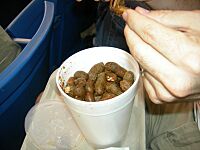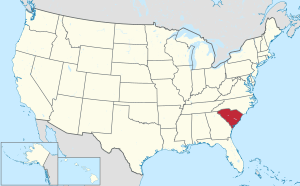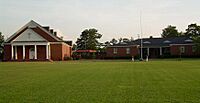List of South Carolina state symbols facts for kids
The state of South Carolina has many official symbols, holidays, and special designations. These symbols were chosen to show off the state's history, its natural resources, and its future possibilities. The palmetto tree and crescent moon on the state flag are South Carolina's most famous symbols. You can see them everywhere, from shirts to bumper stickers! People often change them a bit to show support for their favorite sports teams or activities.
Contents
Symbols of State Power
South Carolina has special symbols that show it is a strong and independent state. These symbols remind people where the state's power comes from.
- The state House of Representatives has used a special mace since 1880. A mace is a ceremonial staff. When the House is meeting, the mace sits in a special spot in front of the Speaker of the House.
- The state Senate uses a sword of state. The current sword was a gift from Lord Halifax, a British ambassador. It has been used since 1951. The first sword was from 1704 and was used by the governor of the South Carolina Colony.
- The state flag was first created for the soldiers who fought for independence in 1776.
- The Seal of South Carolina was chosen in 1776. The seals of the Senate and House also show the sword of state and the mace.
South Carolina's Official Symbols
Here is a list of South Carolina's official state symbols and when they were chosen:
- State Amphibian: spotted salamander (Ambystoma maculatum) (1999)
- This salamander is the only amphibian found all over the state.
- Third-grade students from Woodlands Heights Elementary School suggested it.
- State Animal: white-tailed deer (Odocoileus virginianus) (1972)
- You can find white-tailed deer in every county in South Carolina.
- State Beverages:
- State Beverage: milk (1984)
- Milk was chosen because it is healthy.
- Dairy farms are found in 39 of South Carolina's 46 counties.
- State Hospitality Beverage: tea (Camellia sinensis)
- Tea was first grown in the United States in South Carolina in 1799.
- You can still find tea growing at the Charleston Tea Garden today.
- State Beverage: milk (1984)
- State Birds:
- State Bird: Carolina wren (Thryothorus ludovicianus) (1948)
- The wren was chosen because its song can be heard all year long.
- Before 1948, the mockingbird was the state bird.
- State Wild Game Bird: wild turkey (Meleagallopavo) (1976)
- Wild turkeys live all over the state.
- People hunt them during a special spring season.
- State Duck: wood duck (Aix sponsa) (2009)
- The wood duck is also known as the summer duck or the Carolina duck.
- State Bird: Carolina wren (Thryothorus ludovicianus) (1948)
- State Butterfly: eastern tiger swallowtail (Papilio glaucus) (1994)
- An English artist named Mark Catesby drew the first picture of this butterfly in South Carolina in 1725.
- State Color: indigo blue (2008)
- This color comes from the uniforms of the 2nd South Carolina Regiment from the Revolutionary War.
- The state flag is indigo blue to remember this group of soldiers.
- The palmetto tree on the flag reminds us of their successful defense of Charleston. They used a fort built of palmetto logs!
- State Craft: sweetgrass basket weaving
- Sweetgrass grows along the coast of the Carolinas.
- African slaves used their traditional skills to make tightly woven baskets from it.
- This special skill has been passed down through many families.
- You can still find many basket weavers near Mount Pleasant.
- State Dances:
- State Dance: shag (1984)
- The shag was chosen because it started in South Carolina.
- State American Folk Dance: square dance (1994)
- Square dancing is important to South Carolina's culture.
- State Waltz: "Richardson Waltz" (2000)
- This waltz came from the family of Richard Richardson, a general from the American Revolutionary War.
- State Dance: shag (1984)

- State Dog: Boykin Spaniel
- This dog breed was first raised in South Carolina near Camden.
- It is a small dog with a curly brown coat and golden eyes.
- Boykin Spaniels were first bred to hunt waterfowl.
- They are known for being happy and full of energy.
- People also call them the "swamp poodle" or "the little brown dog."
- State Grass: Indian grass (Sorghastrum nutans) (2001)
- The General Assembly said that Indian grass is a "native, nonnoxious plant." This means it grows naturally and isn't harmful.
- State Fish: striped bass or rockfish (Morone saxatilis) (1972)
- You can catch large striped bass, weighing 30 to 40 pounds, in the Santee Cooper lakes.
- This makes bass fishing a very popular activity.
- State Flowers:
- State Flower: yellow jessamine (Gelsemium sempervirens)
- When yellow jessamine returns each spring, it reminds people to be loyal and patriotic to the state.
- It is a very common flower found all over South Carolina.
- State Wildflower: goldenrod (Solidago altissima)
- Goldenrod was chosen because its flowers last a long time.
- State Flower: yellow jessamine (Gelsemium sempervirens)
- State Fossil: Columbian mammoth (Mammuthus columbi) (2014)
- State Fruit: peach (Prunus persica) (1984)
- South Carolina is the second largest producer of peaches in the United States.
- California grows the most, and South Carolina grows more than Georgia (which is known as the "Peach State").
- State Gemstone: amethyst (1969)
- South Carolina is one of the few U.S. states where you can find good quality amethyst gems.
- State Heritage Horse: Carolina Marsh Tacky (2010)
- The Marsh Tacky is a rare horse breed unique to South Carolina.
- It played a big part in the state's history.
- These horses were left by the Spanish on the South Carolina Sea Islands about 500 years ago.
- State Heritage Work Animal: mule (2010)
- State Insect: Carolina mantid (Stagmomantis carolina) (1988)
- One reason this insect was chosen is because it helps farmers by eating harmful insects.
- State Marine Mammal: bottlenose dolphin (Tursiops truncatus) (2009)
- State Migratory Marine Mammal: northern right whale (Eubalaena glacialis) (2009)
- You can find right whales off the coast of South Carolina during their breeding season.
- State Mottos:
- Dum spiro spero (While I breathe, I hope)
- This motto appears on some of the state's license plates.
- Animis opibusque parati (Ready in soul and resource) (1777)
- Both state mottos are shown on the state seal.
- The seal shows the defeat of the British on Sullivan's Island in 1776.
- Dum spiro spero (While I breathe, I hope)
- State Music: spiritual (1999)
- Spirituals are songs that came from the oral traditions of African-American slaves.
- "Swing Low, Sweet Chariot" is a very famous example.
- Spirituals were first written down on St. Helena Island during the Civil War.
- State Pecan Festival: The South Carolina Pecan Festival in Florence County (2011)
- State Popular Music: beach music (2001)
- Beach music is closely connected to the state dance, the shag.
- It is also thought to have started in Myrtle Beach.
- State Reptile: loggerhead sea turtle (Caretta caretta) (1988)
- The loggerhead is a threatened species.
- These turtles build their nests on the shores of South Carolina.
- State Shell: lettered olive (Oliva sayana) (1984)
- A South Carolinian, Dr. Edmund Ravenel of Charleston, found and named the lettered olive.

- State Snack: boiled peanuts
- Boiled peanuts are a popular snack in the southern U.S.
- State Songs:
- "Carolina" (1911)
- "South Carolina On My Mind" (1984)
- Both state songs were written by people from South Carolina.
- State Spider: Carolina wolf spider (Hogna carolinensis) (2000)
- The idea for the state spider came from a third-grade student.
- It was a way for other students to learn more about this native spider.
- State Stone: blue granite (1969)
- Many buildings in the state are made with blue granite mined in South Carolina.
- State Tartan: The Carolina tartan (2002)
- The Carolina Tartan honors the Scottish settlers who came to South Carolina in the late 1600s.
- State Tapestry: "From the Mountains to the Sea" (2000)
- This tapestry is on display at the South Carolina Cotton Museum.
- It shows scenes of the state on a cotton fabric.
- State Tree: sabal palmetto (Sabal palmetto) (1939)
- The palmetto has been a symbol for South Carolina since the American Revolutionary War.
- It was used to build a fort on Sullivan's Island that helped stop a British attack.
- The palmetto tree appears on the first state symbol, the seal created in 1777.
- It is a very popular state symbol.
- State Vegetable: collard (2011)
- When it was adopted, South Carolina was the second largest producer of collards in the United States.
South Carolina's Official Holidays and Observances
These are the holidays in South Carolina when state government offices are closed:
- January 1: New Year's Day
- Third Monday in January: Martin Luther King, Jr. Day
- Third Monday in February: George Washington's birthday/President's Day
- May 10: Confederate Memorial Day
- Last Monday in May: National Memorial Day
- July 4: Independence Day
- First Monday in September: Labor Day
- November 11: Veterans Day
- National Thanksgiving Day and the day after
- December 24, 25, and 26
South Carolina also observes many special days and weeks throughout the year:
- February: American History Month is for celebrating American history.
- Third Saturday in February: Purple Heart Day honors those who received the Purple Heart medal.
- March 18: John C. Calhoun's birthday is South Carolina Day. On this day, schools teach about the state's history and resources.
- Last week in April: Golf Week celebrates the golf industry and young golfers.
- May 1: Loyalty Day.
- First Friday in May: Vietnam Veterans Survivors' and Remembrance Day.
- Friday before Mother's Day: Family Respect Day recognizes the importance of family.
- Second Sunday in May: Mother's Day.
- First week of June: South Carolina State Guard Week.
- June 28: Carolina Day remembers the anniversary of the Battle of Fort Sullivan in 1776.
- Week beginning first Sunday of June: Garden Week.
- Last week in August: Family Week. The South Carolina Family of the Year is honored during this week.
- September 11: A State Day of Remembrance for the victims of the September 11, 2001 attacks. It also honors first responders and emergency workers.
- Third Friday in September: POW/MIA Recognition Day remembers military personnel who were prisoners of war or missing in action.
- October 11: General Pulaski Memorial Day remembers Casimir Pulaski's service in South Carolina during the American Revolution.
- Second Sunday in October: Grandmother's Day.
- Fourth Friday in October: Frances Willard Day teaches children about avoiding alcohol.
- Week including November 11: Patriotism Week honors military veterans and their sacrifices.
- First Friday of December: Arbor Day encourages planting trees on school property.
- December 15: Bill of Rights Day celebrates the anniversary of the Bill of Rights.
Other Official State Designations
South Carolina has also given official titles to certain places and things:
- The pledge to the flag of South Carolina is: "I salute the flag of South Carolina and pledge to the Palmetto State love, loyalty and faith."
- The South Carolina Botanical Garden at Clemson University is the official state botanical garden.
- The South Carolina Tobacco Museum in Mullins is the official tobacco museum.
- The South Carolina Railroad Museum in Winnsboro is the official railroad museum.
- Camden Military Academy is the official military academy.
- The South Carolina Hall of Fame, located in the Myrtle Beach Convention Center, is the official state hall of fame.
- The South Carolina Artisans Center, in Walterboro, is the official folk art and crafts center.
- In 2001, the Abbeville Opera House became the official state rural drama theater.
See also
- Index of South Carolina-related articles
- Lists of United States state insignia
- State of South Carolina



